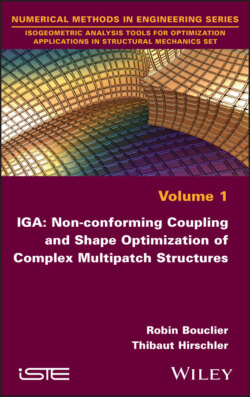Читать книгу IGA - Robin Bouclier - Страница 33
1.5.2. Penalty coupling
ОглавлениеLet us start by defining the functional spaces m and m over domain Ωm that will contain the displacement solution and test functions, respectively:
[1.37]
To account for the coupling in the penalty approach, the interface Dirichlet condition [1.36a] is weighted with its test counterpart, multiplied with a penalty parameter αpen and added to the standard virtual work formulation of the uncoupled problem. In this way, we obtain the following variational formulation for the penalty coupling: find (u1, u2) ∈ 1 × 2, such that:
[1.38]
where the standard bilinear form am and the linear form lm associated with domain Ωm (m ∈ {1, 2}) can be written as:
[1.39]
and denotes the jump operator as follows:
[1.40]
In the above equations, we note that we use the notations ・ and : to refer to the scalar product of vector fields and of second-order tensor fields, respectively.
It is important to note that the accuracy of the method strongly depends on the choice of the penalty parameter. Indeed, a large value for αpen is necessary to enforce the kinematic compatibility [1.36a]; however, making it too large makes the discrete coupled system ill-conditioned. A related drawback with this basic penalty method is that it is variationally inconsistent, in the sense that we cannot recover the interface conditions [1.36] of the strong form by using the weak form [1.38], especially the equilibrium of the tractions [1.36b]. Finally, it has to be noted that the stiffness operators of the sub-domains are merged together, which may complicate the separation of the computational resources between the different sub-domains. For all of these reasons, we will not consider this method in this book. Nevertheless, given its simplicity, we quote that the penalty approach remains of interest in IGA. Some efforts are currently performed to enhance such penalty techniques for isogeometric non-conforming coupling, in particular, with respect to the choice of the penalty parameter (see, for example, Herrema et al. (2019) and Coradello et al. (2020)).
